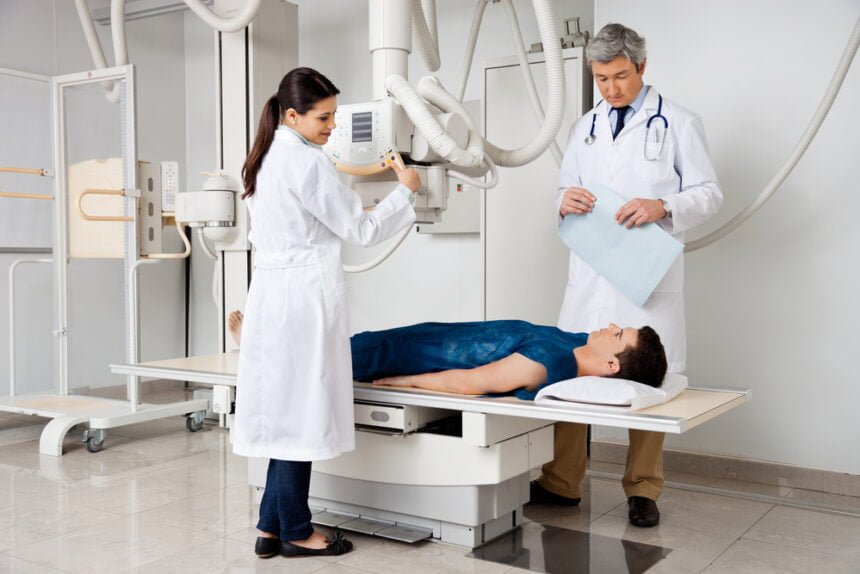Since its groundbreaking discovery in 1895, X-ray technology has been a fundamental tool in medical diagnosis, constantly evolving to enhance treatment planning and patient care. Its evolution from simple bone imaging to advanced techniques like digital radiography illustrates a remarkable trajectory in healthcare innovation.
Today, this imaging technology offers non-invasive insights into the human body, playing a crucial role in accurately diagnosing various conditions, from hidden fractures to complex diseases, and aiding clinicians in formulating effective treatment strategies.
Applications Of X-Ray Technology In Various Medical Fields
The advancement of X-ray technology has significantly influenced various medical disciplines. Here are four fields where its application has been particularly transformative:
- Orthopedics: X-ray imaging is indispensable in orthopedics for evaluating bone fractures, joint disorders, and skeletal abnormalities. It facilitates precise diagnoses, informs surgical planning, and monitors healing processes, thereby significantly improving outcomes in musculoskeletal care.
- Dentistry: Dental X-rays are essential in diagnosing and managing oral health conditions. They enable my dentist to conduct a detailed examination of dental caries, assess tooth root health, identify periodontal disease, and plan for orthodontic treatments.
- Pulmonology: In pulmonology, X-ray imaging is fundamental for diagnosing lung conditions such as pneumonia, tuberculosis, and lung cancer. It provides valuable information for the treatment and management of various respiratory diseases, significantly aiding in improving respiratory health.
- Cardiology: X-rays are indispensable for procedures like cardiac catheterization and for visualizing heart and vascular conditions. They aid in diagnosing coronary artery diseases, guide the placement of stents, and are crucial in various interventional cardiology procedures.
The application of X-ray technology in these specialties highlights its versatility and vital contribution to modern healthcare.
Enhancing Diagnostic Precision With X-Ray Technology
Advancements in X-ray technology have dramatically enhanced diagnostic precision in medical practice. This enhancement is evident in various aspects of X-ray imaging, each contributing significantly to the accuracy of diagnoses and treatment planning.
- Detection Of Subtle Abnormalities: The enhanced sensitivity of modern X-rays is crucial in identifying subtle anatomical changes, which might indicate the onset of a disease or an underlying condition. This advanced detection capability aids in diagnosing conditions before they manifest into more serious stages, thus improving the chances of successful treatment.
- Precise Imaging For Accurate Treatment Planning: High-resolution X-ray images provide detailed internal views, enabling clinicians to develop more accurate and personalized treatment plans. This precise imaging ensures that treatments address the specific medical issues of each patient.
- Early Detection Of Progressive Diseases: X-ray technology plays a significant role in identifying diseases in their initial stages, especially those that progress over time. Early identification of such conditions is crucial for timely intervention, often altering the disease’s trajectory and improving patient prognosis.
- Real-Time Imaging For Immediate Assessment: Technologies like fluoroscopy offer real-time X-ray imaging, which is advantageous for immediate diagnosis and assessment during medical procedures. This immediate feedback is essential in surgeries and other interventions where quick decision-making is important.
- 3D Imaging For Complex Diagnosis: Advanced X-ray systems capable of producing 3D images provide a comprehensive view of the body’s structures. This depth of imaging is particularly beneficial in complex cases, allowing for a more thorough and accurate assessment.
X-ray technology continues to evolve, playing a significant role in refining diagnostic precision and thereby enhancing the overall quality of patient care.
Limitations And Risks Associated With X-Ray Imaging
While X-ray technology is integral in modern diagnostics, it’s important to acknowledge its inherent limitations and associated risks. Understanding these aspects is vital for both healthcare professionals and patients to ensure informed decision-making and optimal use of this diagnostic tool.
- Exposure To Ionizing Radiation: The exposure to ionizing radiation during X-ray procedures poses a potential health risk, especially with repeated exposures over time. This risk, which includes the potential for cellular damage and increased cancer risk, is of particular concern in sensitive populations such as children and pregnant women.
- Reduced Efficacy In Soft Tissue Visualization: X-rays are less effective in detailing soft tissues, limiting their utility in diagnosing conditions involving muscles, tendons, and internal organs. This limitation often necessitates the use of complementary imaging methods like magnetic resonance imaging (MRI) or computerized tomography (CT) scans for a full diagnostic picture.
The medical field continuously implements strategies to mitigate these risks, including the use of digital X-ray technology, which requires lower radiation doses. Adherence to safety protocols like protective shielding and ongoing advancements in imaging technology are also critical in enhancing patient safety while maintaining diagnostic accuracy.
Future Directions In X-Ray Technology
Advancements in X-ray technology are rapidly shaping the future of medical diagnostics, promising enhanced precision and safety.
- Advanced Imaging Techniques: Upcoming innovations like dual-energy X-ray absorptiometry (DEXA) are focused on delivering clearer images with reduced radiation. This improves diagnosis, especially in critical areas like oncology.
- Artificial Intelligence (AI) Integration: The incorporation of AI and machine learning is set to further refine X-ray diagnostics by enhancing image analysis and predictive accuracy, thereby streamlining the process.
The continued evolution of X-ray technology heralds a new era in healthcare, marked by smarter imaging and improved patient outcomes.
Final Thoughts
The evolution of X-ray technology has helped advance medical diagnostics. It has continuously improved the accuracy of diagnoses and the effectiveness of treatment plans. This progress has enabled earlier disease detection and more precise monitoring.
The future of this technology holds promising advancements. With ongoing developments in imaging techniques and the integration of artificial intelligence, the potential for further enhancing diagnostic precision is substantial. These innovations are set to further reduce risks and improve healthcare outcomes, marking another step forward in medical technology.

